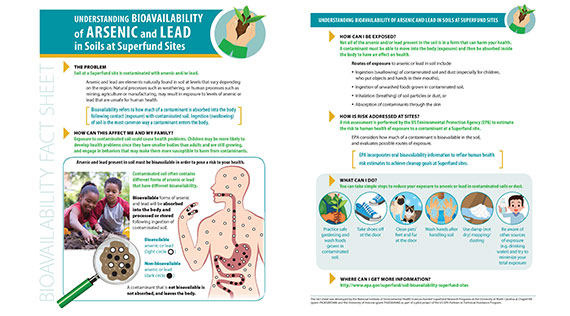Understanding Bioavailability of Arsenic and Lead in Soils at Superfund Sites
The University of Arizona Superfund Research Program (UA SRP) and University of North Carolina-Chapel Hill SRP collaborated to develop a new community information sheet on bioavailability, which was finalized and released in the summer of 2016. The collaboration began in the spring of 2015, as a pilot project in the US EPA Partners in Technical Assistance Program (PTAP). Former UA SRP Research Translation Core Leader Dr. Sarah T. Wilkinson worked with Kathleen Grey, Dana Haine, and Sarah Yelton at UNC SRP, as well as PTAP coordinator Melissa Dreyfus, US EPA Office of Superfund Remediation and Technology Innovation. Together, they developed a fact sheet entitled, “Understanding Bioavailability of Arsenic and Lead in Soils at Superfund Sites”. Experts within the US EPA Bioavailability working group offered feedback and approved the final version of the fact sheet, which is now freely available for community members, educators, and SRP or US EPA personnel.
The concept of bioavailability, and its implications for cleanup decisions, may be unknown or confusing for communities impacted by metals contamination. The fact sheet provides a brief introduction to the concepts of bioavailability of contaminants, describing how metal bioavailability can affect people’s health and how people can be exposed. It also mentions the simple steps people can take to reduce their exposure to arsenic or lead in contaminated soils or dust and provides references to more information. Click here to access the factsheet on the UA SRP website.
Stay-tuned for additional community educational materials being finalized, which complement the fact sheet, and include a PowerPoint presentation, and worksheets and facilitator’s guide for a hands-on activity. These interactive materials have been piloted with expert and community audiences, with additional input form the US EPA Bioavailability working group. They can be used at community meetings, and offer a visual, interactive way to learn more about concepts of bioavailability at Superfund sites.


